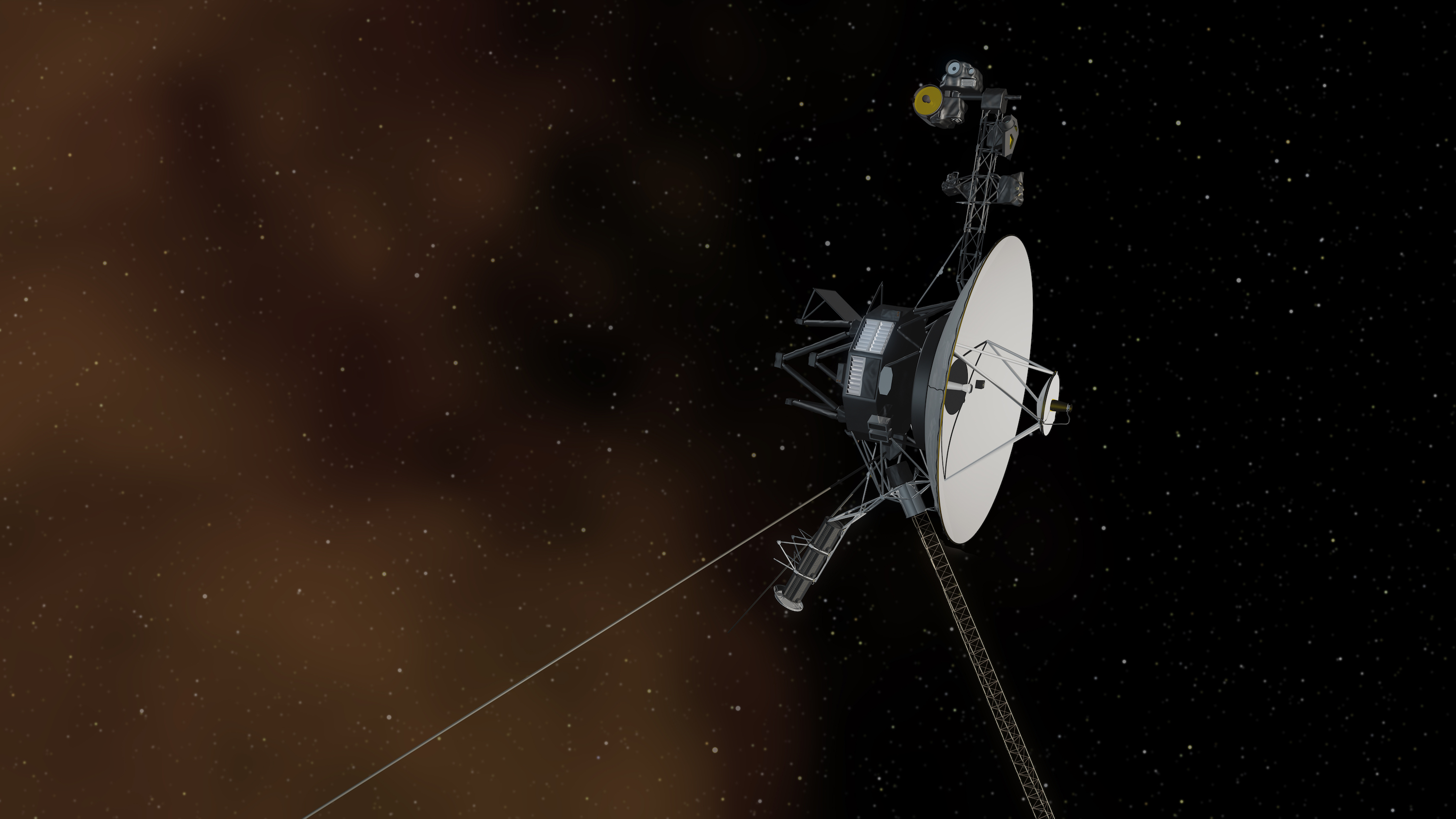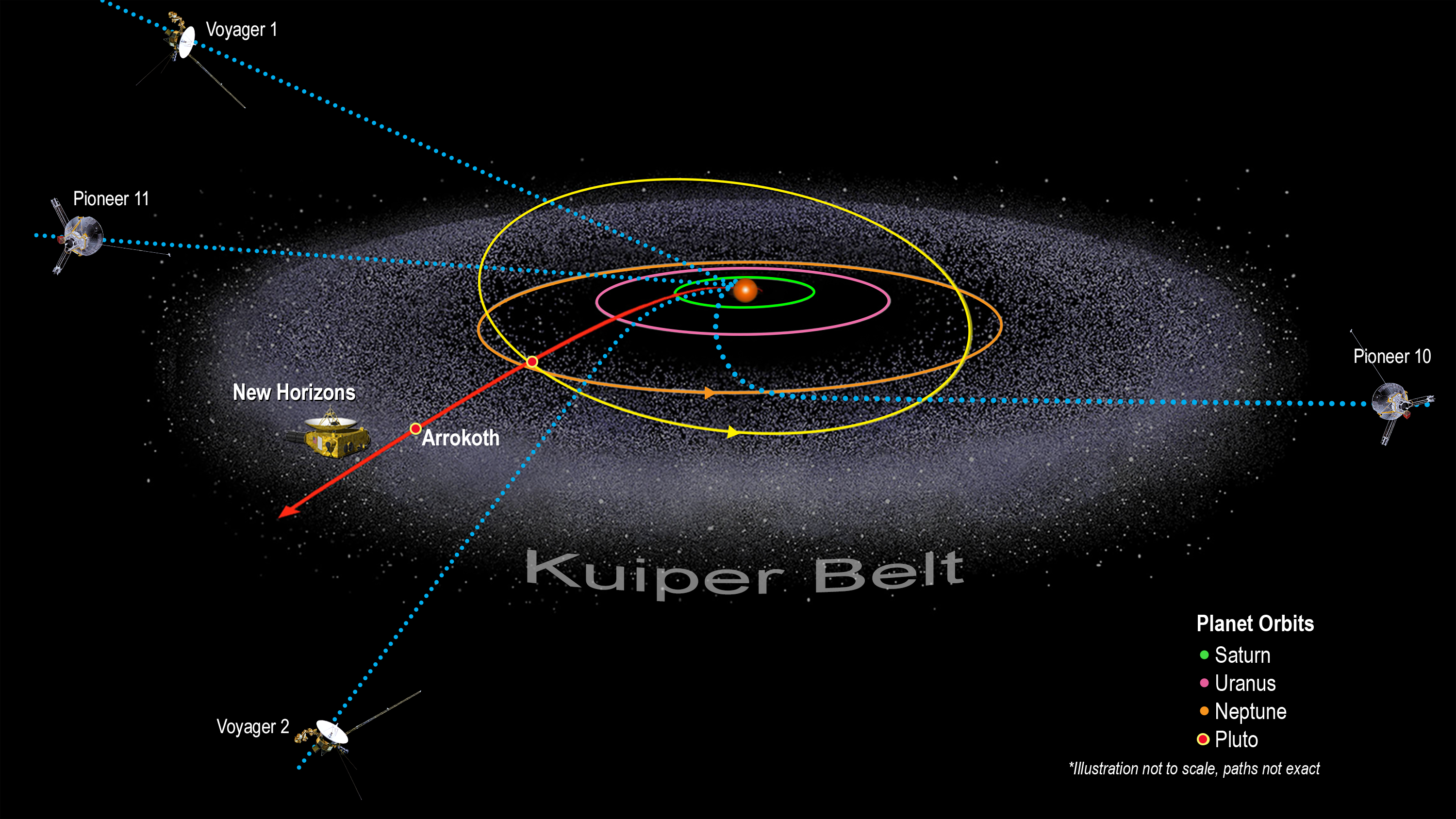The most distant spacecraft in the solar system — Where are they now?

Humans have been flinging things into deep space for 50 years now, since the 1972 launch of Pioneer 10. We now have five spacecraft that have either reached the edges of our solar system or are fast approaching it: Pioneer 10, Pioneer 11, Voyager 1, Voyager 2 and New Horizons.
Most of these probes have defied their expected deaths and are still operating long beyond their original mission plans. These spacecraft were originally planned to explore our neighboring planets, but now they're blazing a trail out of the solar system, providing astronomers with unique vantage points in space — and they've been up to a lot in 2022.
Voyagers 1 and 2
The Voyager missions celebrated a very special anniversary this year: 45 years of operations. From close fly-bys of the outer planets to exploring humans' furthest reach in space, these two spacecraft have contributed immensely to astronomers' understanding of the solar system.
Related: Voyager: 15 incredible images of our solar system captured by the twin probes (gallery)
Their main project now is exploring where the sun's influence ends, and other stars' influences begin. Voyager 1 crossed the heliopause, the boundary where the sun's flow of particles ceases to be the most important influence, in 2012 with Voyager 2 following close after, in 2018.
"Voyager 1 has now been in interstellar space for a decade…and it's still going, still going strong," Linda Spilker, Voyager project scientist and a planetary scientist at NASA's Jet Propulsion Laboratory (JPL) in California, told Space.com.
The mission team hit one major hiccup this year, when the spacecraft began sending home garbled information about its location. The engineers found the cause — the spacecraft was using a bad piece of computer hardware when it shouldn't have — and restored operations.
Get the Space.com Newsletter
Breaking space news, the latest updates on rocket launches, skywatching events and more!
These kinds of incidents are to be expected with an aging spacecraft, though. The team is also actively managing the power supply onboard each spacecraft, which is dwindling each year as the probes' radioactive generators grow increasingly inefficient. This year, mission personnel turned off heaters keeping a number of scientific instruments on board warm in the harsh, cold environment of space — and, much to everyone's surprise, those instruments are still working perfectly well.

The cameras may have been turned off decades ago, but the spacecrafts' other instruments are collecting data on the plasma and magnetic fields from the sun at a great distance away from the star itself. Because particles of the solar wind — the constant stream of charged particles flowing off the sun — take time to travel such a long way, distant observations allow scientists to see how changes from the sun propagate throughout our cosmic neighborhood.
The edges of the solar system have been full of surprises, too. It would make sense that plasma from the sun becomes more sparse and spread out as you move away from the center of the solar system, but in fact, the Voyagers have encountered much denser plasma after crossing the heliopause. Astronomers are still puzzled about that one.
"It's just so amazing that even after all this time we continue to see the sun's influence in interstellar space," Spilker said. "I'm looking forward to Voyager continuing to operate, perhaps reaching the 50th anniversary."
Pioneers 10 and 11
The Pioneer spacecraft hold a special place in space history because of their role as, you guessed it, pioneers. Unfortunately, these milestone 50-year-old spacecraft are non-functional — Pioneer 10 lost communications back in 2003, and Pioneer 11 has been silent since its last contact in 1995.
But both these spacecraft are marks of humanity's presence in the solar system, and they are still continuing on their journeys, even if we're not sending them commands or firing their rockets anymore. Once a spacecraft is set on a trajectory out of the solar system, according to the laws of physics, it won't stop unless something changes its course.
New Horizons
New Horizons is by far the youngest sibling of these groundbreaking missions, having just launched in 2006. After completing its famous flyby of dwarf planet Pluto in 2015, this probe has been zooming out of the solar system at record speed, set to reach the heliopause around 2040.
Not only has it completed its primary mission, but it successfully completed a flyby of the smaller Kuiper Belt object, Arrokoth, in 2019 as its first mission extension. Earlier this year, the spacecraft was put into hibernation mode because an extended mission hadn't yet been approved. But now, the team is excitedly moving into New Horizons' 2nd Kuiper Belt Extended Mission, or KEM2 for short. KEM2 began on Oct. 1, although the spacecraft will hibernate until March 1, 2023.
In the meantime, the mission team is preparing for exciting new observations. With cutting-edge instruments — far more advanced than what the Voyagers carried in the 1970s — the team is prepared to use New Horizons as a powerhouse observatory in the distant solar system, providing a viewpoint we can't achieve here on Earth.
Bonnie Burrati, planetary scientist at JPL and member of the New Horizons team, is particularly looking forward to new views of Kuiper Belt objects (KBOs), the chunks of ice and rock beyond Neptune. New Horizons' unique position in the outer solar system provides new angles of looking at these KBOs, she said. Different views can tell astronomers about how rough the objects' surfaces are, among other things, based on how light scatters and creates shadows on them.
Another planetary scientist on the team from Southwest Research Institute in Colorado, Leslie Young, wants to use the spacecraft for a new look at something closer to home: the ice giants, Uranus and Neptune. New Horizons’ unique viewpoint provides scientists with information about how light scatters through the planets’ atmospheres—information we can’t get from here on Earth, since we can’t see Uranus and Neptune from that angle. Planetary scientists are eager for more information about these planets, especially as NASA begins planning for a new mission to visit Uranus.
When the spacecraft wakes from hibernation, it will be past the so-called "Kuiper cliff," where scientists currently think there are far fewer large KBOs. "When we look at other star systems, we see debris disks extending to much larger distances from their host stars," Bryan Holler, an astronomer at Baltimore's Space Telescope Science Institute, told Space.com. "If ET were to look at our solar system, would they see the same thing?"
This next extended mission will even venture beyond New Horizons' original domain of planetary science. Now, the spacecraft will provide better-than-ever measurements of the background of light and cosmic rays in space, trace the distributions of dust throughout our solar system, and obtain crucial information on the sun's influence, complimentary to the Voyagers. Since the three functional far out spacecraft are heading in separate directions, they allow astronomers to map out irregularities in the solar system's structure.
Luckily for New Horizons, signs indicate that the spacecraft will have enough power to last through the 2040s and possibly beyond — each year, moving 300 million miles (480 million kilometers) farther into uncharted territory.
Follow the author at @briles_34 on Twitter. Follow us on Twitter @Spacedotcom and on Facebook.
Join our Space Forums to keep talking space on the latest missions, night sky and more! And if you have a news tip, correction or comment, let us know at: community@space.com.

Briley Lewis (she/her) is a freelance science writer and Ph.D. Candidate/NSF Fellow at the University of California, Los Angeles studying Astronomy & Astrophysics. Follow her on Twitter @briles_34 or visit her website www.briley-lewis.com.









